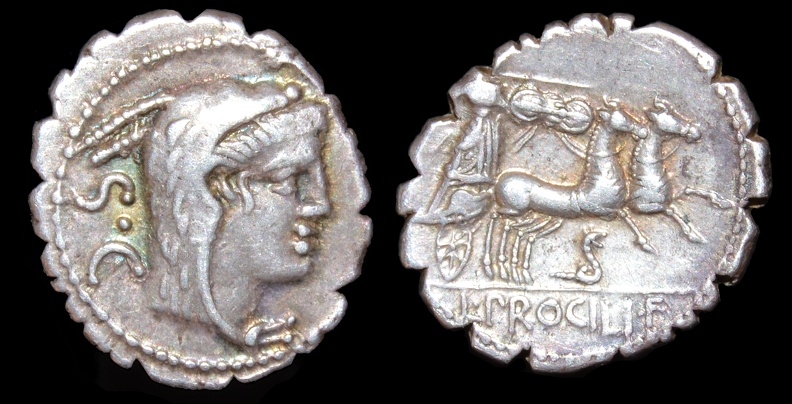
Roman Republic L. Procilius AR denarius serratus(3.895g, 19.3mm). Rome, 80 BC. Head of Juno Sospita right, wearing goat-skin headdress; S•C behind / L PROCILI F, Juno Sospita, holding spear and shield, in biga right; serpent below. Crawford 379/2; Sydenham 772; Procilia 2; Russo RBW 1407.
Ex Andrew McCabe collection, privately purchased from Roma Numismatics in 2009
From FORVM's description of the significance of Juno Sospita, pictured on this denarius: "In Roman mythology, Juno was the daughter of Saturn and the wife of Jupiter. Among her many attributes was Juno Sospita, who offered protection to women, accompanying them throughout their lives from birth to death. She was often called upon by infertile women to aid in conception. Juno Sospita had two temples at Rome, but her most famous temple was at Lanuvium. Her statue there, as described by Cicero and as depicted on coinage, wore a goatskin coat with a goat-horned headdress. This statue may the one now at the Vatican. Her attribute, the serpent, inhabited a grotto near her temple, and was fed annually by a young girl, who, if a virgin, escaped unharmed, but if not, was destroyed."
Crawford only lists two types from gens Procilia, both of which were issued by this same moneyer and both of which feature Juno Sospita on the reverse(the other features Jupiter on the obverse). The designs on his denarii seem to imply the moneyer hails from Lanuvium, but there are no other historical sources for this that I am aware of. Crawford believes that he is likely the same Procilius that Cicero records being prosecuted and condemned for misconduct in the year 56 and in fact may even be the historian Procilius.